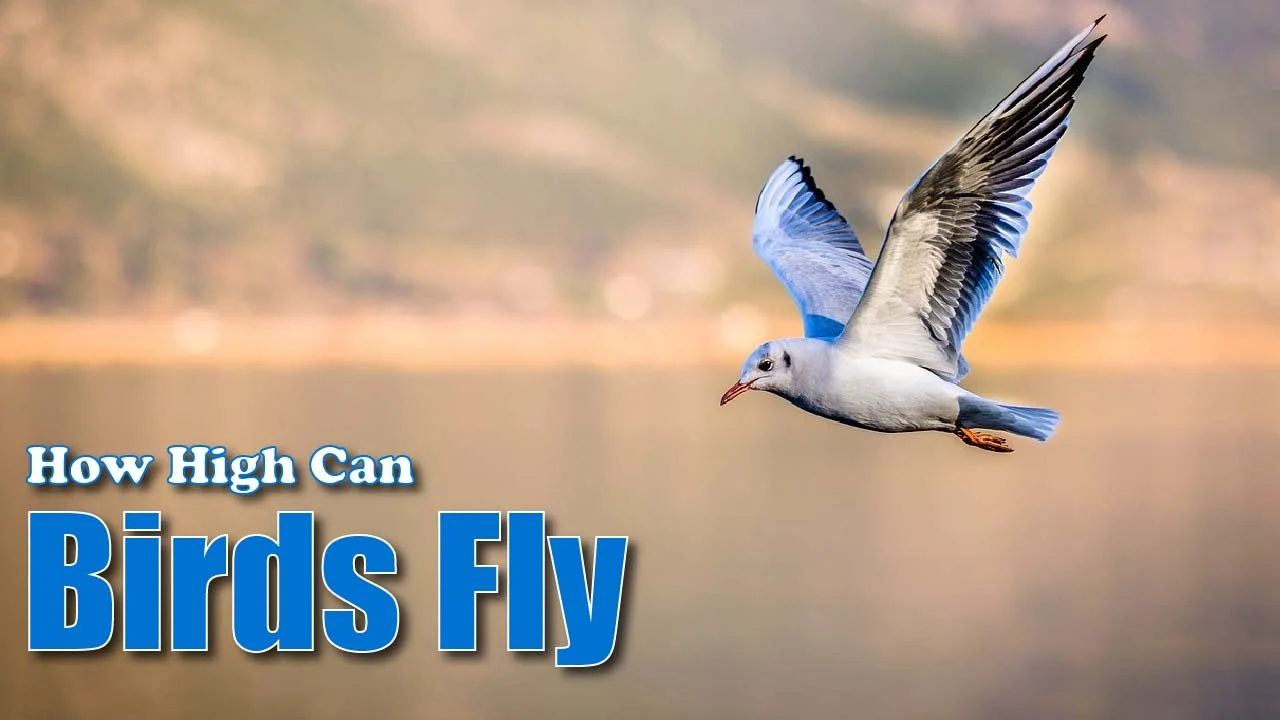Birds are beautiful creatures that fly in the sky. People have loved watching them for a long time. We wonder: How high can birds fly? Let’s learn about it! We’ll explore how birds can fly so high and what helps them. Come with us on this adventure!
The Basics of Bird Flight
Understanding Avian Anatomy
Before we embark on our journey to explore the heights birds can reach, we must grasp the fundamentals of their anatomy. Birds possess lightweight skeletons, streamlined bodies, and powerful muscles—all tailored for flight. Birds have hollow and light bones, which helps them stay in the air. Their feathers keep them warm and help them fly better, too.
How High Can Birds Fly?
Exploring Altitude Limits
Birds can fly at different heights. It depends on what kind of bird they are, the weather, and how their bodies work. Some birds fly low or medium, but some can go high when they travel or look for food.
Factors Affecting Bird Flight Altitude
Physiological Adaptations
-
Efficient Respiratory Systems: Birds have special air sacs that help them breathe better when they fly.
-
Lightweight yet Sturdy Bones: Hollow bones provide structural support without adding excessive weight.
-
Powerful Musculature: Well-developed flight muscles generate lift and thrust for agile flight maneuvers.
-
Streamlined Body Shape: Birds have smooth bodies that help them fly better by making it easier to move through the air.
-
Enhanced Visual Acuity: Birds have perfect eyes that help them see far away. Their eyes can find things from really far away.
Environmental Influences
-
Air Density: When birds fly high, the air gets thinner. This makes it harder for them to stay in the air and fly well.
-
Temperature Gradients: Temperature variations influence air density and thermoregulation during flight.
-
Wind Patterns: Wind speed and direction impact flight stability and maneuverability.
Species-specific Traits
-
Wing Morphology: Variation in wing shape influences flight performance and altitude capabilities.
-
Metabolic Rates: Energy demands for flight vary among species based on metabolism and physiology.
-
Migratory Behavior: Migration patterns and geographic barriers affect altitude preferences.
-
Altitudinal Range: Some species are adapted to specific altitude ranges for habitat and foraging.
-
Foraging Strategies: Foraging behavior influences flight altitude preferences and adaptation.
Highest Flying Birds
Overview of Species
Several avian species are renowned for their remarkable ability to soar to heights. Some fantastic birds that can fly high are albatrosses, bar-headed geese, and Rüppell’s griffon vulture. They each have unique ways to fly at high altitudes.
Albatrosses: Masters of Long-distance Flight
-
Large Wingspans: Albatrosses have enormous wings stretching over 11 feet, which helps them glide through the air quickly.
-
Efficient Gliding Techniques: These birds fly far across the ocean by gliding smoothly. They save energy when they fly for a long time.
-
Altitude Capability: Albatrosses can fly high, over 15,000 feet up. They are super good at flying far over the big ocean.
Bar-headed Geese: High Altitude Migrants
-
Migratory Prowess: Bar-headed geese take a tough trip every year. They fly over the big Himalayan mountains and Mount Everest during their migration.
-
Altitude Endurance: These strong geese can fly high, over 29,000 feet. They can handle thin air and harsh weather easily.
-
Physiological Adaptations: Bar-headed geese possess specialized hemoglobin and lung capacity adaptations to cope with oxygen deprivation at high altitudes.
Rüppell’s Griffon Vulture: The Highest Recorded Flight
-
Record-breaking Altitude: Rüppell’s griffon vulture flies high. It went up to 37,000 feet!
-
Thermal Soaring: These birds use warm air to fly up high. This helps them see extensive areas to find food.
-
Adaptability: Rüppell’s griffon vultures are good at living in challenging places. They can handle high places and lousy weather.
Mechanisms of High Altitude Flight
Aerodynamics of Bird Flight
Birds use flapping and gliding techniques to achieve altitude and sustain flight.
-
Flapping: Birds flap their wings in a coordinated manner to generate lift and thrust, propelling them through the air.
-
Gliding: Once birds start flying, they can glide. They use air and wind to stay up without much energy.
Knowing how air works is essential for understanding how birds fly and move around.
Thermoregulation
It’s hard for animals to stay warm in high places because it’s colder, and they lose heat faster.
-
Countercurrent Heat Exchange: Birds have unique ways to keep warm. They use their blood to keep heat inside their bodies.
-
Insulation: Some birds have feathers or fat to stay warm and save energy when they fly high.
Oxygen Utilization
The air gets thinner when you go up high. There’s less oxygen up there, so it’s harder to breathe and get energy from oxygen.
-
Efficient Respiratory Systems: Birds have excellent breathing systems. They have particular lungs and air sacs to get lots of oxygen.
-
Enhanced Hemoglobin Capacity: Birds have special blood that likes oxygen a lot. This helps them breathe better in thin air.
These remarkable changes help birds live in places with less oxygen up high. They can fly and stay healthy without getting too little oxygen.
Limitations to Bird Flight
In the big sky, birds face many problems that affect how high they can fly. Changes in air pressure and less oxygen make it hard for them. These things decide how birds fly and stay alive.
Atmospheric Pressure: Impact on Lift and Performance
-
Decreasing Air Density: As altitude increases, atmospheric pressure decreases, reducing air density.
-
Lift Generation: When the air is thinner, it’s harder for birds to stay up in the air because they can’t lift themselves as efficiently.
-
Flight Performance: Because of changes in the air, birds might be unable to move around or up high.
Oxygen Availability: Coping with Hypoxic Environments
-
Diminishing Oxygen Levels: As you go higher, there’s less oxygen. This makes it harder for birds to get energy from oxygen.
-
Metabolic Demands: Birds must use oxygen carefully to fly high without getting sick from insufficient oxygen.
-
Physiological Adaptations: Some birds have changed their bodies to breathe better in high places. They have solid lungs and unique ways to carry oxygen. This helps them live where there’s not much air.
Energy Expenditure: Balancing Flight Demands and Conservation
-
Substantial Energy Requirements: Flying high takes a lot of energy, especially for birds that travel far.
-
Energy Conservation: To stay alive, birds must save energy while flying long distances.
-
Foraging Challenges: Birds have trouble finding food in high places, so they need to be smart about eating to save energy.
Birds have trouble flying high because of air pressure, oxygen, and energy. But birds can adapt to these challenges. It’s important to know this to help birds stay safe.
Human Interaction with High-Flying Birds
Humans and birds share the sky. It can be tricky, but it also has good parts. We work to keep planes and birds safe. And we help them stay safe and happy.
Aviation Hazards: Understanding Risks and Solutions
-
Bird Strikes: Birds flying high might crash into planes, especially when taking off or landing.
-
Safety Concerns: When birds hit planes, it’s dangerous for birds and people. It can hurt the plane, hurt people, or even cause deaths.
-
Mitigation Measures: To keep everyone safe, people who manage planes use radar and special tools to watch for birds. They also take care of the places where birds live near airports.
-
Detection Systems: Fancy radar and watching machines follow where birds go. They help people who control planes ensure they only fly where it’s safe for birds.
-
Habitat Management: To help keep birds safe, we keep their homes safe near airports. We also ensure nothing makes birds want to come near, like smelly dumps.
-
Research and Innovation: Scientists keep studying how birds act and how to take care of where they live. This helps us get better at stopping birds from crashing into planes.
Conservation Efforts: Safeguarding High-Altitude Habitats
-
Ecosystem Importance: Birds need high places to live, eat, and rest. These places are super essential for them, too.
-
Threats to Habitats: When people build cities, cut trees, or change the weather, it is hard for birds and animals to find good homes.
-
Protected Areas: Governments and groups that care for nature make unique places to keep high homes safe for birds and other animals.
-
Sustainable Practices: Keeping the land clean and safe helps birds have good places to live. It also helps everything in nature stay in balance.
-
Community Engagement: Everything is safe when people living nearby help care for nature. This also allows them to have good lives without hurting the environment.
-
Education and Awareness: Talking about why high places where birds live are important helps people understand. This makes them want to help keep these places safe and care for the environment.
We need to do many things to keep birds safe while meeting people’s needs. We can make rules to help birds fly safely and protect where they live. This allows us to live together with birds and take care of our planet.
Conclusion
How high can birds fly? This question makes us wonder about birds and where they can go. Birds can fly very high, even in cold places like the Himalayas. They can also fly over big oceans. Birds are unique because they can adapt to different places and keep going despite tough times. We must take care of where they live so they can keep flying high.
FAQs
Q. Do all birds have the same ability to fly at high altitudes?
A. Birds are not all the same. Some birds fly high, and some fly low. They can do this because they have different bodies and like other places to live.
Q. What role does air density play in bird flight at high altitudes?
A. The air around us can make it easier or harder for birds to fly high. It affects how much lift they can get and how much oxygen they can find. This decides if they can fly really high or not.
Q. How do birds cope with low oxygen levels at high altitudes?
A. Birds have particular lungs and blood to help them breathe and get oxygen. This allows them to live in places with less oxygen.
Q. Are there any risks associated with high-altitude flight for birds?
A. Flying very high can be dangerous for birds. They might not get enough oxygen, run out of energy, or face bad weather, especially when they fly a long way.
Q. What can we learn from studying bird flight at high altitudes?
A. When we watch birds fly high, we learn how they move, how their bodies work, and how they fit into nature. This helps us with planes and animals and protects nature.

